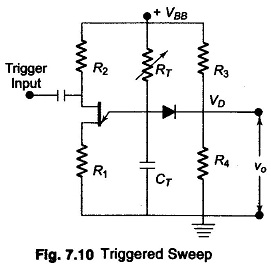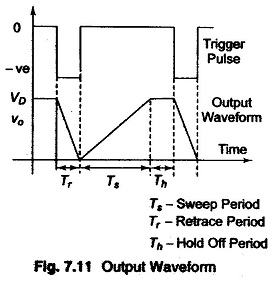Triggered Sweep CRO:
Triggered Sweep CRO – The continuous sweep is of limited use in displaying periodic signals of constant frequency and amplitude. When attempting to display voice or music signals, the pattern falls in and out of sync as the frequency and amplitude of the music varies resulting in an unstable display.
A triggered sweep can display such signals, and those of short duration, e.g. narrow pulses. In triggered mode, the input signal is used to generate substantial pulses that trigger the sweep. Thus ensuring that the sweep is always in step with the signal that drives it.
As shown in Fig. 7.10, resistance R3 and R4 form a voltage divider such that the voltage VD at the cathode of the diode is below the peak voltage VP for UJT conduction. When the circuit is switched on, the UJT is in the nonconducting stage, and CT charges exponentially through RT towards VBB until the diode becomes forward biased and conducts; the capacitor voltage never reaches the peak voltage required for UJT conduction but is clamped at VD.
If now a -ve pulse of sufficient amplitude is applied to the base and the peak voltage V/P is momentarily lowered, the UJT fires. As a result, the CT discharges rapidly through the UJT until the maintaining voltage of the UJT is reached; at this point the UJT switches off and the CT charges towards VBB, until it is clamped again at VD. Figure 7.11 shows the output waveform.

